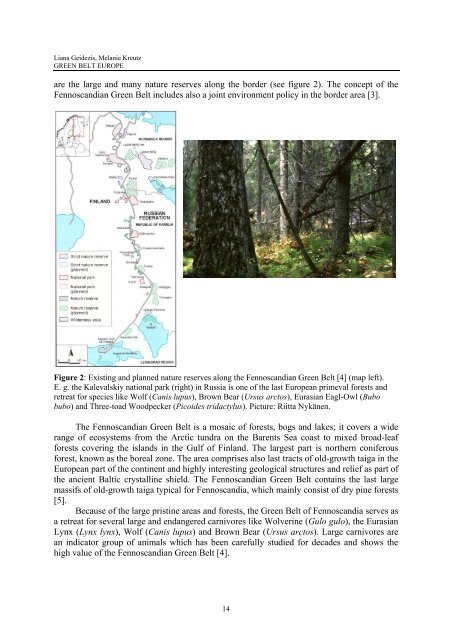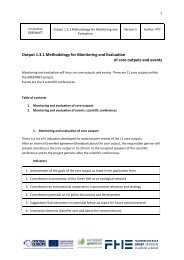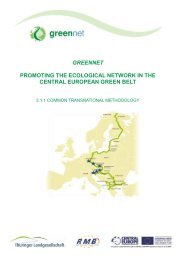The Green Belt as a European Ecological Network strengths and gaps
The Green Belt as a European Ecological Network strengths and gaps
The Green Belt as a European Ecological Network strengths and gaps
You also want an ePaper? Increase the reach of your titles
YUMPU automatically turns print PDFs into web optimized ePapers that Google loves.
Liana Geidezis, Melanie Kreutz<br />
GREEN BELT EUROPE<br />
are the large <strong>and</strong> many nature reserves along the border (see figure 2). <strong>The</strong> concept of the<br />
Fennosc<strong>and</strong>ian <strong>Green</strong> <strong>Belt</strong> includes also a joint environment policy in the border area [3].<br />
Figure 2: Existing <strong>and</strong> planned nature reserves along the Fennosc<strong>and</strong>ian <strong>Green</strong> <strong>Belt</strong> [4] (map left).<br />
E. g. the Kalevalskiy national park (right) in Russia is one of the l<strong>as</strong>t <strong>European</strong> primeval forests <strong>and</strong><br />
retreat for species like Wolf (Canis lupus), Brown Bear (Ursus arctos), Eur<strong>as</strong>ian Eagl-Owl (Bubo<br />
bubo) <strong>and</strong> Three-toad Woodpecker (Picoides tridactylus). Picture: Riitta Nykänen.<br />
<strong>The</strong> Fennosc<strong>and</strong>ian <strong>Green</strong> <strong>Belt</strong> is a mosaic of forests, bogs <strong>and</strong> lakes; it covers a wide<br />
range of ecosystems from the Arctic tundra on the Barents Sea co<strong>as</strong>t to mixed broad-leaf<br />
forests covering the isl<strong>and</strong>s in the Gulf of Finl<strong>and</strong>. <strong>The</strong> largest part is northern coniferous<br />
forest, known <strong>as</strong> the boreal zone. <strong>The</strong> area comprises also l<strong>as</strong>t tracts of old-growth taiga in the<br />
<strong>European</strong> part of the continent <strong>and</strong> highly interesting geological structures <strong>and</strong> relief <strong>as</strong> part of<br />
the ancient Baltic crystalline shield. <strong>The</strong> Fennosc<strong>and</strong>ian <strong>Green</strong> <strong>Belt</strong> contains the l<strong>as</strong>t large<br />
m<strong>as</strong>sifs of old-growth taiga typical for Fennosc<strong>and</strong>ia, which mainly consist of dry pine forests<br />
[5].<br />
Because of the large pristine are<strong>as</strong> <strong>and</strong> forests, the <strong>Green</strong> <strong>Belt</strong> of Fennosc<strong>and</strong>ia serves <strong>as</strong><br />
a retreat for several large <strong>and</strong> endangered carnivores like Wolverine (Gulo gulo), the Eur<strong>as</strong>ian<br />
Lynx (Lynx lynx), Wolf (Canis lupus) <strong>and</strong> Brown Bear (Ursus arctos). Large carnivores are<br />
an indicator group of animals which h<strong>as</strong> been carefully studied for decades <strong>and</strong> shows the<br />
high value of the Fennosc<strong>and</strong>ian <strong>Green</strong> <strong>Belt</strong> [4].<br />
14




